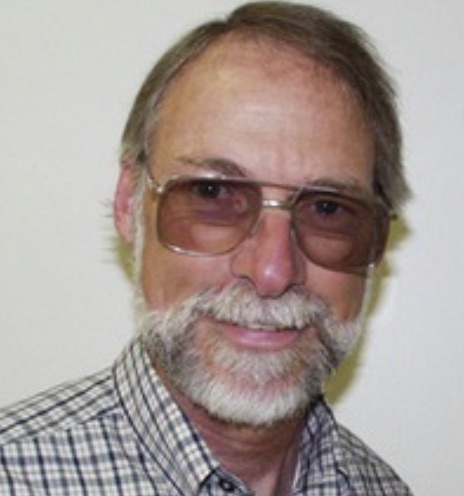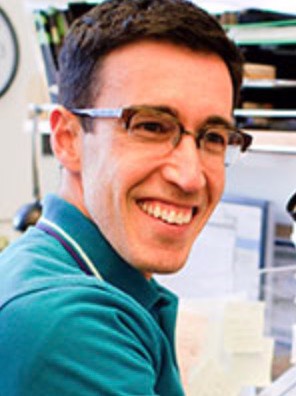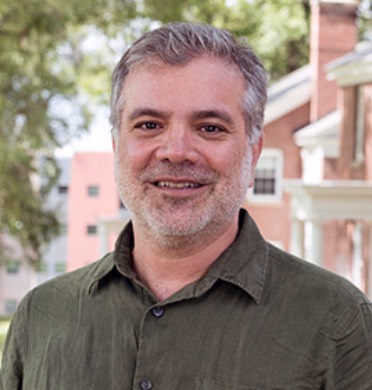Faculty Research
Currently, the CCGS has seventeen principal faculty members pursuing multidisciplinary research in Biological Sciences, Chemistry, Physics, and Mathematics. See below for faculty research statements and contact information.
Markus Babst, Professor, School of Biological Sciences, CCGS Director

Phone: 801-587-7603
Email: m.babst@utah.edu
Office: CSC 124B
Babst Biology Faculty Page
Research in the Babst laboratory focuses on the trafficking of transmembrane proteins in the endosomal system of eukaryotic cells, with particular interest in the mechanisms by which cellular physiology is affecting these protein trafficking routes.
Richard Clark, Professor, School of Biological Sciences

Phone: 801-585-9722, 801-585-5581
Email: clark@biology.utah.edu
Office: BIOL 341
Clark Biology Faculty Page
Research in the Clark laboratory seeks a molecular-genetic understanding of the causes and consequences of genetic variation, primarily using the reference plant, Arabidopsis thaliana.
James Gagnon, Assistant Professor, School of Biological Sciences

Phone: 801-581-5716
Email: james.gagnon@utah.edu
Office: CSC 324B
Gagnon Lab Website
Research in the Gagnon lab focuses on the cell lineage tree - the structure of cell divisions that defines the composition of the organism. We are developing tools to record this tree with CRISPR genome editing. We want to determine how the lineage tree underlies vertebrate embryogenesis and the construction and maintenance of organs.
Ming Hammond, Professor, Chemistry

Phone: 801-213-0892
Email: mingch@chem.utah.edu
Office: CSC 224B
Hammond Lab Website
The Hammond lab has a dual focus on engineering nucleic acids as programmable tools for molecular imaging and gene control, and on understanding the chemistry and biology of cyclic dinucleotides as signaling molecules in bacteria and mammalian cells.
Julie Hollien, Associate Professor, School of Biological Sciences

Phone: 801-587-7783
Email: hollien@biology.utah.edu
Office: CSC 124E
Hollien Biology Faculty Page
The overall goal of the Hollien laboratory is to understand the mechanisms controlling mRNA turnover and the relationships between mRNA stability, localization, and cellular stress pathways, currently focusing on how cells employ mRNA decay in regulating endoplasmic reticulum (ER) function.
Erik Jorgensen, Distinguished Professor, School of Biological Sciences, Investigator/HHMI

Phone: 801-585-3517
Email: jorgensen@biology.utah.edu
Office: ASB 422A
Jorgensen Lab Website
The Jorgensen laboratory is working to identify the proteins that function at the synapse to release and recycle synaptic vesicles by undertaking a genetic analysis of neurotransmission in the nematode Caenorhabditis elegans.
Aaron Puri, Assistant Professor, Chemistry

Phone: 801-213-1408
Email: a.puri@utah.edu
Office: CSC 224F
Puri Lab Website
Research in the Puri lab is focused on how bacteria use natural products to interact with each other and their environment. Current research efforts include therapeutic discovery from underexplored bacterial species and characterization of quorum sensing systems in bacterial communities.
Saveez Saffarian, Associate Professor, Physics

Phone: 801-587-1301
Email: saffarian@physics.utah.edu
Office: CSC 124A
Saffarian Lab Website
Research in the Saffarian laboratory is focused on understanding the molecular mechanism of enveloped virus budding and replication. Specifically the lab is interested in HIV and VSV as model systems for RNA viruses. Our HIV research is focused on how HIV virions assemble all their components and release from infected cells as immature virions and how the immature virions mature to produce fully infectious HIV virions, of particular interest are ESCRT protein interactions with HIV, packaging of Gag-Pol and auto-processing of Gag-Pol by HIV protease. The HIV work is supported by an NIH RO1 award.
Jim Keener, Distinguished Professor, Mathematics

Phone: 801-581-6089
Email: keener@math.utah.edu
Office: LCB 314
Keener Lab Website
The emphasis of the research in the Keener lab is to develop and analyze mathematical models of cell physiological processes. These include study of the effect of extracellular micro domains on cardiac action potential activity, the dynamics of chemical signaling by bacteria, the construction and regulation of flagellar rotary motors, movement of chromosomes during mitosis, the dynamics of swelling of mucus vesicles, and inheritance of DNA methylation patterns in somatic cells.
Baldomero Olivera, Distinguished Professor, School of Biological Sciences

Phone: 801-581-8370
Email: olivera@biology.utah.edu
Office: BIOL 115A
Olivera Lab Website
Research in the Olivera lab has focused on venomous marine snails, in particular, those that belong to the genus Conus ("cone snails"). Cone snails are highly specialized venomous predators. We estimate that there are over 100,000 pharmacologically-active peptides in the venoms of cone snails, and well over 2,000,000 natural products in the venoms of all venomous marine snails (in the superfamily Conoidea). The major research project in our laboratory is the discovery and characterization of these venom components, identification of their molecular targets, and an exploration of potential biomedical applications.
Ofer Rog, Assistant Professor, School of Biological Sciences

Phone: 801-581-3352
Email: ofer.rog@utah.edu
Office: ASB 326
Rog Lab Website
The Rog lab is interested in the large-scale organization of chromosomes. We are using cutting-edge imaging, genetic and genomic approaches in yeast and worms to probe chromosome structure and dynamics during sexual reproduction. Our broad goal is to understand how chromosomes integrate regulatory cues to effect chromosome-wide responses.
Cynthia Burrows, Distinguished Professor, Chemistry

Phone: 801-585-7290
Email: burrows@chem.utah.edu
Office: TBBC 1625
Burrows Lab Website
The Burrows lab studies the chemistry and biology of oxidative stress acting upon DNA and RNA to create base modifications. Notably, we have discovered that G-quadruplexes are hotspots for oxidative damage, and that modifications of guanine induced by cellular free radicals alter gene expression via DNA repair pathways important in cancer and neurological disease.
Vahe Bandarian, Professor, Chemistry

Phone: 801-581-6636
Email: vahe@chem.utah.edu
Office: TBBC 3625
Bandarian Lab Website
Research in the Bandarian lab is centered in developing molecular level understanding of biosynthesis of complex natural products. Specifically, the lab has reconstituted the key steps in the biosynthesis of the modified transfer RNA base, queuosine, which is found in all kingdoms of life. Future directions in this area will include probing the biological role of this and other ubiquitous RNA modification. Additional new areas of research being initiated will focus on mechanistic studies of enzymes involved in complex radical-mediated transformations.
Jessica M.J. Swanson, Assistant Professor, Chemistry

Phone: 801-581-7485
Email: j.swanson@utah.edu
Office: TBBC 4613
Swanson Lab Website
Biological systems wrap many layers of complexity and eons of evolution into finely tuned function, and arguably more complex, intermixed dysfunction. Research in the Swanson lab aims to probe medically and environmentally relevant biological processes at the molecular level. Combining electronic structure data, ab initio and classical molecular dynamics simulation, enhanced free energy sampling methods, and kinetic models, we study processes across a range of time and length scales, ultimately revealing key mechanistic insight.
Jason Shepherd, Associate Professor, Neurobiology & Anatomy

Phone: 801-585-6214
Email: jason.shepherd@neuro.utah.edu
Office: SMBB 4539
Shepherd Lab Website
Brains have an amazing ability to learn and store information for long periods - in some cases, a lifetime. A major challenge in neuroscience is to understand how neuronal networks are sculpted by experience and how proteins/genes contribute to circuit modification. The goal of our research is to understand information storage, from the molecular level through in vivo neuronal networks and how these processes go awry in neurological disorders. My lab utilizes coordinated biochemical, cell biological, electrophysiological and imaging studies both in vitro and in vivo.
Jessica Brown, Associate Professor, School of Biological Sciences

Phone: 801-581-6517
Email: brown@biology.utah.edu
Office: CSC 234B
The Brown lab takes a highly interdisciplinary approach spanning genetics, cell biology, microscopy, genomics, whole genome sequencing, gene expression analysis, and molecular biology in microbial culture, cell culture, and mouse infection model systems. The ultimate goal is to apply our biological knowledge to additional pathogenic fungi and facilitate new anti-fungal therapy development.
Matthew Mulvey, Professor, School of Biological Sciences

Phone: 801-581-5967
Email: mulvey@biology.utah.edu
Office: CSC 224A
The Mulvey lab aims to define mechanisms by which pathogenic strains of Escherichia coli colonize diverse host niches, persist, and spread in the face of numerous environmental stresses, innate and adaptive host defenses, aggressive competition with other microbes, and exposure to antibiotics. We are especially interested in understanding how intraspecies genetic diversity and bacterial adaptive responses impact host-microbe interactions and the manifestation of variable disease phenotypes.
